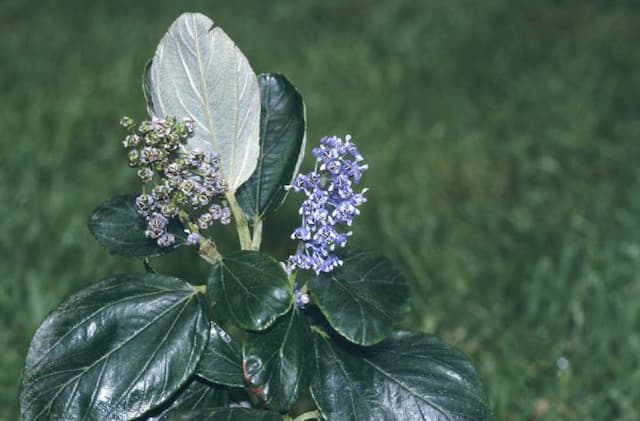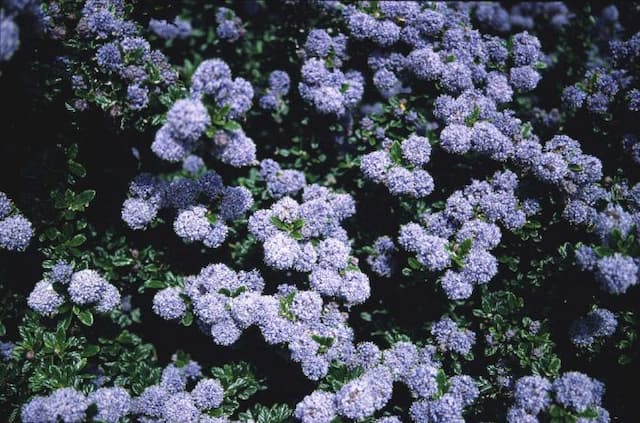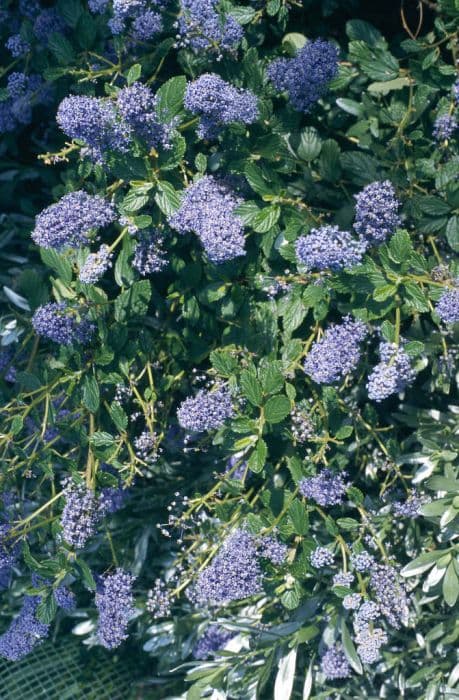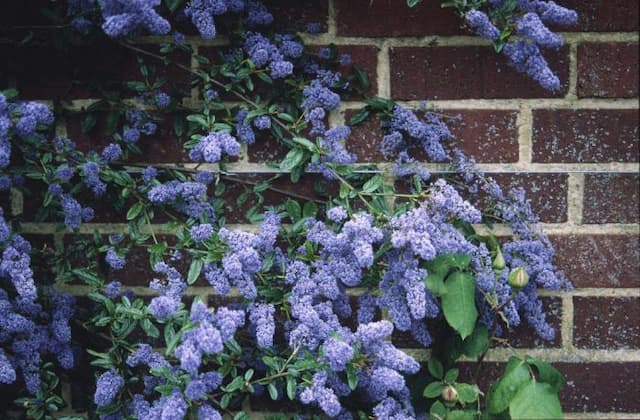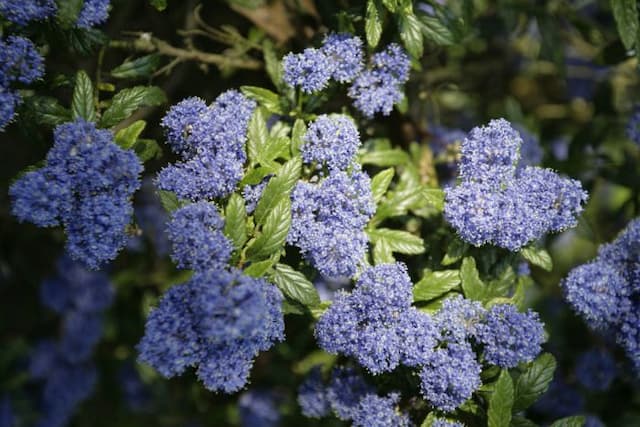Ceanothus 'Autumnal Blue'

ABOUT
Ceanothus 'Autumnal Blue,' commonly known as California Lilac, is a visually striking shrub with a profusion of deep blue flowers that bloom predominantly in the late summer and autumn period, hence its name. The plant bares dense clusters of these tiny, rich blue blossoms which are incredibly attractive to bees, butterflies, and other pollinating insects. The leaves of the California Lilac 'Autumnal Blue' are equally impressive. They are glossy, with a deep green hue, and are typically quite small and oval-shaped, sometimes with pointed tips and finely toothed edges, emitting a fresh scent when crushed. The shrub itself is evergreen, providing year-round interest and color in garden settings. The branches form a bushy habit, often arching gracefully under the weight of the blooms. The California Lilac's rugged attractiveness and strong sea-blue floral display create a captivating visual in gardens, making it a cherished plant among gardeners looking to add a splash of vibrant color and naturalistic charm to their landscapes.
About this plant
 Names
NamesFamily
Rhamnaceae
Synonyms
California Lilac, Blueblossom, Wild Lilac
Common names
Ceanothus 'Autumnal Blue'.
 Toxicity
ToxicityTo humans
California Lilac (Ceanothus 'Autumnal Blue') is not generally considered toxic to humans. There is little information suggesting that ingestion of this plant causes significant harm. However, as with many plants, it may cause mild discomfort, such as stomach upset, if ingested in large amounts. It is always best practice to avoid eating any part of ornamental plants due to potential individual sensitivities or the presence of harmful substances.
To pets
California Lilac (Ceanothus 'Autumnal Blue') is not known to be toxic to pets. It is not listed as a plant with significant toxic effects to dogs or cats. Pets may experience mild gastrointestinal upset if they ingest large quantities of this plant, which is a common reaction to the ingestion of plant material. Supervision is advised to prevent your pet from consuming plants, as individual reactions can vary.
 Characteristics
CharacteristicsLife cycle
Perennials
Foliage type
Evergreen
Color of leaves
Green
Flower color
Blue
Height
6-9 feet (1.8-2.7 meters)
Spread
8-10 feet (2.4-3 meters)
Plant type
Shrub
Hardiness zones
7
Native area
North America
Benefits
 General Benefits
General Benefits- Attracts Pollinators: Ceanothus 'Autumnal Blue', commonly known as California lilac, draws bees, butterflies, and other beneficial insects, promoting biodiversity in the garden.
- Drought Tolerance: Once established, this California lilac is known for its ability to withstand periods of drought, making it suitable for water-wise landscapes.
- Aesthetic Appeal: With its vibrant blue flowers and glossy green leaves, it enhances the visual appeal of gardens and landscapes.
- Fast Growth: This shrub is known for its rapid growth rate, which means it can provide quick coverage or fill in spaces in a relatively short time.
- Low Maintenance: Requires minimal care once established, being resilient to many pests and diseases and needing little pruning or feeding.
- Erosion Control: The robust root system of California lilac helps stabilize slopes and prevent soil erosion in hilly or uneven areas.
- Evergreen Foliage: This variety maintains its foliage throughout the year, ensuring a constant display of greenery in the garden.
- Fragrance: The blossoms of California lilac have a light, pleasing scent that can add another layer of enjoyment to a garden setting.
- Habitat Support: Acts as a habitat and food source for wildlife, including birds and mammals, contributing to a healthy ecosystem.
- Privacy Screening: Its dense growth habit makes it ideal for creating natural privacy screens or windbreaks in a landscape design.
 Medical Properties
Medical PropertiesThis plant is not used for medical purposes.
 Air-purifying Qualities
Air-purifying QualitiesThis plant is not specifically known for air purifying qualities.
 Other Uses
Other Uses- The California lilac's durable wood can be used for making small wooden objects, such as handles and utensils, due to its strength and density.
- Beekeepers value the California lilac as a source of nectar when planted near apiaries, as it can improve honey production with its profuse blossoms.
- The dense foliage and rapid growth habit of California lilac can provide quick and effective erosion control on slopes and banks.
- Gardeners may use the California lilac as a natural screen or hedge to increase privacy due to its thick growth pattern.
- With its attractive blue flowers, California lilac can be used in floral arrangements and as cut flowers for interior decoration.
- California lilac can be planted as part of a butterfly garden as its flowers attract butterflies and serve as host plants for their larvae.
- The plant's extensive root system makes it useful for reinforcing perimeters and boundaries to prevent soil from washing away.
- California lilac's flower clusters could be used as a natural dye source, offering shades of blue and green when used in traditional dyeing processes.
- Bonsai enthusiasts sometimes choose California lilac for creating miniature tree representations due to its small leaves and attractive blooming habits.
- California lilac can provide habitat and shelter for small wildlife and beneficial insects within a garden ecosystem.
Interesting Facts
 Feng Shui
Feng ShuiThe California lilac is not used in Feng Shui practice.
 Zodiac Sign Compitability
Zodiac Sign CompitabilityThe California lilac is not used in astrology practice.
 Plant Symbolism
Plant Symbolism- Hope: Ceanothus, also known as California Lilac, is often associated with hope due to its lush, vibrant blooms that signify nature’s optimism and renewal.
- Endurance: The hardy nature of the California Lilac symbolizes endurance and the ability to withstand challenging conditions, much like it does in its natural rugged California habitat.
- Patriotism: In some contexts, the California Lilac's blue flowers represent loyalty and patriotism, as the plant's native status and blue color can be reminiscent of traditional American values.
- Good Fortune: The abundant flowering of the California Lilac is sometimes seen as a sign of good fortune and prosperity, adding a positive omen to its presence in a garden.
 Water
WaterCalifornia lilac generally requires moderate watering, particularly during its growing season in the spring and summer. For established plants, water deeply once every two weeks, allowing the soil to dry out between waterings. This translates to approximately 1-2 gallons depending on the size and maturity of the plant. During the hottest parts of the year, you may need to water more frequently, especially if the plant is in well-draining soil or a hot, sunny location. Reduce watering in the fall and winter when the plant is dormant.
 Light
LightCalifornia lilac thrives in full sun, meaning it should receive at least six hours of direct sunlight daily. It's best planted in a spot where it can enjoy morning light and some protection from intense afternoon sun, particularly in hotter climates. However, the plant is versatile and can also tolerate a bit of light shade, which may help prevent leaf burn during the peak of summer heat.
 Temperature
TemperatureCalifornia lilac prefers mild climates and can be quite frost-hardy. The plant can survive in temperatures as low as 10 degrees Fahrenheit and up to about 100 degrees Fahrenheit. However, it thrives when temperatures are consistently between 50 and 70 degrees Fahrenheit. Ensure the plant has protection from extreme cold by placing it in a sheltered location if temperatures frequently drop below its minimum tolerance.
 Pruning
PruningCalifornia lilac benefits from pruning to maintain its shape and encourage flowering. Prune immediately after flowering to avoid cutting off next year's buds, typically in late spring or early summer. Remove no more than one-third of the growth to ensure the plant remains healthy. Pruning can also include thinning out older stems to allow light and air to reach the interior of the plant, which encourages new growth and improves the plant's overall health.
 Cleaning
CleaningAs needed
 Soil
SoilCalifornia Lilac (Ceanothus 'Autumnal Blue') thrives in well-drained soil with a pH between 5.5 and 7.5. A soil mix of equal parts loam, sand, and peat or compost will provide proper drainage and nutrients. Avoid heavy clay soils and ensure adequate organic matter for best growth. Mulching can help retain moisture and cool the root system.
 Repotting
RepottingCalifornia Lilac rarely needs repotting as it prefers to be left undisturbed. It's typically repotted only when essential, like when it outgrows its container, which is not frequent. Generally, repotting might be considered every 3 to 5 years, but often it's best to just refresh the top layer of soil.
 Humidity & Misting
Humidity & MistingCalifornia Lilac prefers moderate humidity levels but is quite adaptable and can tolerate lower humidity typical of the climates it naturally thrives in. Avoid excessive humidity as it may promote fungal diseases.
 Suitable locations
Suitable locationsIndoor
Provide bright light, avoid overwatering.
Outdoor
Full sun, well-drained soil, shelter from harsh winds.
Hardiness zone
7-10 USDA
 Life cycle
Life cycleThe Ceanothus 'Autumnal Blue', commonly known as Autumnal Blue California Lilac, starts its life as a seed, which after a period of dormancy, typically requires a trigger such as fire or scarification to germinate. Upon germination, the seedling will establish roots and a shoot that will grow into a young plant. As the plant matures, it develops woody stems and evergreen leaves, entering a vegetative state that allows for vigorous growth. When mature, the Autumnal Blue California Lilac blooms in late summer or autumn, producing clusters of blue or violet flowers that attract bees and butterflies. Following pollination, the flowers develop into fruit (capsules) that contain seeds, completing the reproductive cycle. As a perennial shrub, it can live for several years, with flowering and seed production occurring annually, and it may eventually die back as part of its natural aging process or due to environmental stressors.
 Propogation
PropogationPropogation time
Spring to Summer
The most popular method of propagation for the California Lilac 'Autumnal Blue' is through semi-hardwood cuttings. This process usually takes place during the summer months when the new growth has begun to mature but is not yet fully hardened. To propagate, a gardener should select a healthy branch and cut a piece that is about 6 to 8 inches long (15 to 20 centimeters). The cutting should include at least two sets of leaves. The bottom set of leaves is removed, and the cut end can be dipped into rooting hormone to increase the likelihood of successful rooting. The prepared cutting is then planted in a well-draining soil mix, ensuring that the node where the bottom leaves were removed is buried. The cuttings should be kept moist and in a shaded area until roots have developed and the plant can be gradually acclimated to more direct sunlight.
